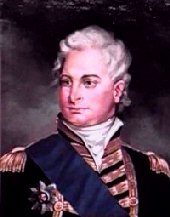 On July 20, 1786, the King's son, William Duke of Clarence, later
King William IV of England came to the Placentia station. On his
arrival he was appointed surrogate of the district and lietenant
governor of Placentia. Prince William did not approve of the
liberty granted to Roman Catholics, and one of his first actions
was to forbid them from using the court house for mass. He also
forbade any Catholics to be buried in the Protestant burying
ground. He then summoned the parish Priest to appear before him
and show proof of permission to build the chapel that was under
construction. The parish priest appeared before the court with
the written permission of the governor. The prince was then
unable to prevent construction of the Catholic chapel.
On July 20, 1786, the King's son, William Duke of Clarence, later
King William IV of England came to the Placentia station. On his
arrival he was appointed surrogate of the district and lietenant
governor of Placentia. Prince William did not approve of the
liberty granted to Roman Catholics, and one of his first actions
was to forbid them from using the court house for mass. He also
forbade any Catholics to be buried in the Protestant burying
ground. He then summoned the parish Priest to appear before him
and show proof of permission to build the chapel that was under
construction. The parish priest appeared before the court with
the written permission of the governor. The prince was then
unable to prevent construction of the Catholic chapel. Like the other seamen of his time the Prince was very strict on discipline. On one occasion a fight broke out between several men in the town. The prince ordered a party of marines to seize them and bring them back to the ship. One of the men brought back was given a hundred lashes before it was discovered that they had the wrong man.
The Prince took a deep interest in the betterment of the town and he orderd a new Anglican church to be built. To start off a fund for this purpose he donated 50 guinnes of his own money.
He also took a deep interest in a Placentia boy named Collins, it has always been said that this lad was his natural son by a local woman. The boy was sent to England and entered the Royal Navy. He rose to the rank of lieutenant but his career was cut short when he drank a toast in the ward room "to the King's health and a rope's end to Billy Pitt the then Prime Minister of England. Collins was sent back to Placentia, but his influential friends later had him reinstated. It was too late however, and he died at Placentia. For many years afterwards his sword was on display in the old court house.
It seems the Prince first began his sea life at the age of 14, serving in the American Revolutionary War. His parents, King George III and Queen Charlotte then sent him to school in Germany where his not so Royal antics resulted in punishment at sea. Although the prince expressed his desire to serve his time in the Mediterranean, his parents chose to station him on the south coast of Newfoundland.
In 1786 Prince William Henry, Duck of Clarence was posted to Placentia as Captain of the HMS Pegasus. His duties included patrolling the coasts, reporting on the fisheries and acting as surrogate magistrate for the Placentia district.
While in Placentia he was involved in the Construction of the church of England chapel. Before leaving Newfoundland to take up similiar duties in Halifax, the Prince presented a silver communion set to the church of England congregation at Placentia. The service was made of sterling silver in 1786 by Edward Fennell of London. The four-piece set includes an ewer, chalice, paten and collection plate.
St. Luke's church owns this service, but for security reasons, the Bradshaw family of Placentia held the communion service for many years. It is now held by the Anglican Cathedral of St. John the Baptist, St. John's.
The communion set was on exhibit when Placentia celebrated the trecentenary in 1962 and again in 1986 on the 200-year anniversary of St. Luke's Church. The service was also displayed at Castle Hill during the Matthew Visit to Placentia in the summer of 1997.
He arrived in Placentia on July 1, 1786 and left on September 5, 1786 spending most of that time as a surrogate court judge.
Before dealing with his activities as a naval surrogate, we shall briefly survey the other noteworthy events that took place in Placentia during the Prince's stay, the tacit ones being ship maintenance, the brewing of spruce beer, and the repeated floggings by this martinet commander.
On July 21, a much-respected seaman by the name of William Eddy died in Placentia, and, as Bryam Martin says, "his messmates dug and formed a remarkably neat grave for him, and having no chaplain, the Prince read the funeral service in a very impressive manner.